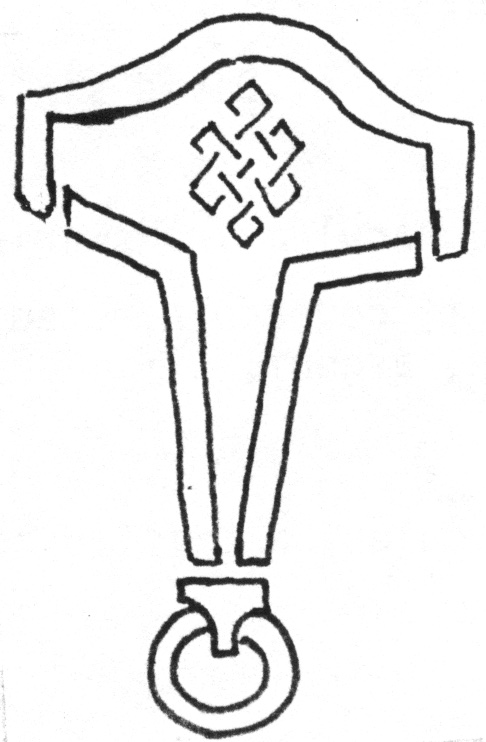
Mjöllnir pendant
Eastmarch
3 Las Palomas
Orinda CA 94563
29 October XI (1976)
Karina of the Far West, Laurel Queen of Arms,
to the Heralds of the four Kingdoms,
Greetings.
Below you will find the rest of the acceptances and rejections for this month. There are not as many of them as I thought: thirty-four acceptances and thirty-three rejections, for a total of sixty-seven. (I am now only about six months behind, instead of a year, which has got to be some kind of improvement.) I will not be issuing any more acceptances or rejections until my staff has done the input for the next edition of the Armorial and Ordinary, which will be done (insert your favorite deity or phenomenon willing) this Sunday.
Please let me know the [m]undane names and addresses of the people who should receive your Kingdom's extra two copies for this edition.
* Quiauhxochitl: Or, goutté azure, a beavertail cactus* blossoming proper. (* Opuntia basilaris)
This is Nahuatl for Rain Flower. I like it a lot!
* Allyn Macemaker: Badge for the Sojourners' Company. Barry wavy argent and azure, two flaunches vert.
A badge for former residents of Thairis.
* Anya de Calais: Purpure, a chalice between two quatrefoils, all in fess; in base a key fesswise; all Or.
* Aonghais Dubh macTarbh: (Alteration of arms: previous arms revert to personal badge.) Sable, semé of flames proper, a horse salient argent incensed, cried of flames, unguled and fetlocked gules, ducally gorged proper.
* Cooks' Guild, Carolingia: Argent, counterissuing from a pie a blackbird*, and in chief a blackbird* volant, all proper. * Turdus merula, a thrush, not related to American blackbirds (family Icteridae, related to starlings).
That's a proper pie.
* Danamas of Starlinghurst: Azure, on a crenelated wall issuant from dexter argent, a starling counter-close argent perching upon a nest Or.
I trust you are aware that "hurst" does not mean "nest."

* Leonard the Younger: Gules, a Mjöllnir-pendant inverted, pierced, and within the head a mascle-[k]not of six corners argent.
Careful comparison of runestones and amulets convinces me that this represents the latter. Even on stones, the hammer is placed haft-up, as a decorative element, and head-up only when held in Thor's hand. I can only describe the curious fretwork as a mascle knot.
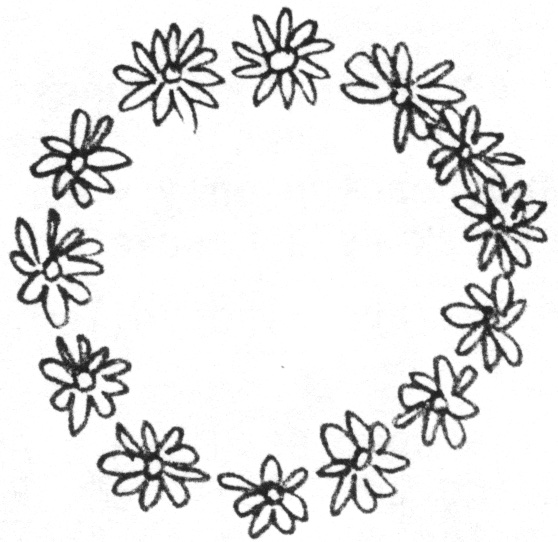
* Marguerite la Folle: Azure, a wreath of white marguerites* proper. * Chrysanthemum frutescens
Marguerites are also yellow. A wreath is drawn as shown, not as an ellipse.
* Michael Gyrfalcon of Elden: Azure, a white gyrfalcon's* head erased proper within an orle of roundels Or. * Falco islandus
The species given ("Arctic" gyrfalcon, F. rusticolus) has several subspecies, including the "Asiatic" F. r. uralensis, and "Black", F. r. obsoletus. I judge from the picture that the "White" (Icelandic) species is the one desired.
* Peregrine Anorial of the Further Isles: Gyronny Or and azure, a brown sandstone tower proper, port and light Or.
"Port" means door. "Light" is an obsolete term for "window"; I like it better than the heraldically used "port-hole." This castle appears to be of reddish-brown sandstone with white mortar.
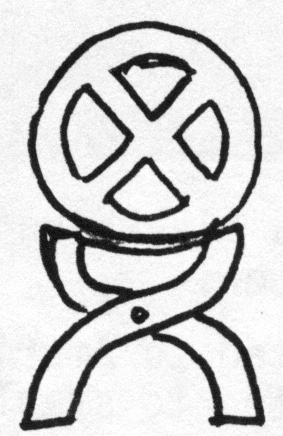
* Raymond the Gruesome, badge: Azure, a wheel of four spokes in saltire upon the seat of a curule chair, Or.
A curule chair is a kind of folding camp-stool, having curved legs and no sides or back. Its use was a mark of great distinction. (Note that curule is an adjective.)
* Richard of Rideja: Chevronelly sans nombre argent and gules, a spearhead sable.
The highest number Parker mentions for a field chevronelly is seven. This is seventeen, counting partials; hence "sans nombre."
* Shoi-Mee D'Skeemah the Confused: Sable, from the points of a Star of David six arrows couped below the head.
"Two triangles voided and interlaced" is referred to in SCA heraldry as a "Mogen David" or "Star of David."
* Thairis, Protectorate (Propugnaculum Transmarinum): Azure, a demi-aurochs rampant, couped invected, environed of a laurel wreath, argent.
* Tnek the Ainissestor: Per bend sinister sable and gules, a griffin counter-segreant argent.
* Barbara-Katherine of Kenilworth, Alteration of name from "Barbara of Kenilworth". The device (Quarterly gules and vairy Or and gules, a cross lozengy throughout Or, in the first quarter a stag courant above an oak leaf fesswise, also Or) remains unchanged (unfortunately).
* Cata dels Vergiers de Lemozí: a domestic cat sejant affronte gules orbed Or between two Oriental dancer's-bells gules; a bordure sable.
"Bell" alone means a church bell. "Oriental bell" would mean a temple bell. "Dancer's bell" would mean Morris-dancer's bell unless otherwise specified.
* Elizabeth Karien of the Four Winds: Completion of name, formerly "Elizabeth". The device (Checky argent and vert, a horse's head couped sable) remains unchanged.
* Gabriele die Gütige: Per pale vert and azure, on a pale gules fimbriated Or a goblet Or; to dexter, in pale two oak leaves bendwise Or: to sinister the same bendsinisterwise.
* Geoffrey of Tannelorn: Argent, seven triangles erect azure conjoined in bend sinister debased, in sinister chief a roundel Or fimbriated gules.
"Erect" means conjoined so ![]() not so
not so ![]() .
.
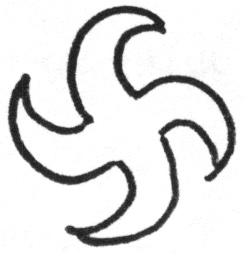
* Gwynneth of Sanquebar: Azure, a fess argent between two crosses gurgitee Or.
A new, heraldic name for an ancient solar symbol.
* John Fulton: Badge (as First Merchant) for the House of the Candy Merchants: Bendy gules and argent, a pale counter-changed.
DISPLAY ON A ROUNDEL, NOT A SHIELD! [I like it. Very nice.] I can almost taste the peppermint.
* Joseph the Hunter: Per bend argent, a heart gules, and sable, a lightning bolt bendwise argent.
Permission has been obtained from Julie of Blackwater and William the Recorder of Blackwater (his parents).
* Judith the Rose: Argent, a damask rose* slipped and leaved proper. *Rosa damascena
Known since classical times.
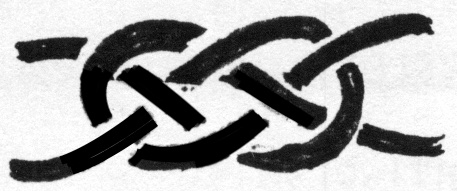
* Kemreth Danil: Vert, two pythons erect respecting each other, their tails nowed in a Wake knot, argent.
The heraldic python has wings. I assume you are surrendering your previously accepted device.
* Louis le Blanc lou Boumian: Badge: Azure, a bendlet Or surmounted by a pale argent; in sinister canton a fleur-de-lys Or.
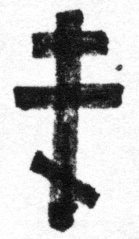
* Peregrine Ignatius Dominic Augustine Doran: Sable, a bend sinister between a Latin cross and a Greek Orthodox cross, all argent.
"Ignatius" is not from Latin ignōtus, but Greek and of unknown meaning. If you meant "Doran" is Welsh for "flame" my Welsh dictionary doesn't give it at all. You misspelled Augustine. As a name it's all right. Your eke-name, Monsignor Friar Pippin, won't do: it's like entitling yourself "Colonel Corporal So-and-So."
* Richard Ironsteed: Badge for House Bonne Amitié: Argent, an iris azure, bearded Or, slipped and leaved vert.
* S'ikhijvālā: Badge for House Gehe Candra: Argent, within a domed minaret balcony an increscent doublearched, all sable.
(Transfer of this badge from Nis'a Vani, which name she is releasing. It's the same lady, also known as Chala Gaja.)
* Shuaib Hassan: Argent chapee sable, a cinquedea gules ornamented Or.
A cinquedea is a large dagger "five fingers broad," sixteenth century Italian. See Stone's A Glossary of the Construction, Decoration, and Use of Arms and Armor, pp. 181-2 (Jack Brussel, New York, 1961).
* Steffan the Well-Learned: Quarterly gules and vert, a cross Or, in dexter chief a great horned owl's* head erased proper. *Bubo virginianus
* Thor's Mountain, Shire: Argent, three piles inverted throughout sable, within a laurel wreath overall vert a stone throwing hammer argent.
* Vīryavān ca Tūṣṇīṃ: Argent, a cobra affrontee erect, tail and body doubly nowed, sable scaly Or, hooded sable.
* Yukio no Yamaguchi: Device: Ermine, in chief a fountain; issuant from base a sun in splendor. Badge: A katana fesswise [edge down, point to sinister] proper.
[The etiquette of position is minute. For a Japanese sword, a katana is by default edge up, but a tachi (a sword worn at court and with armor) is by default edge down.]
* Aultain Moire O'Linnala. We will no longer accept "wavy-crested" (characterized in Boutell is "new"). It is too far out of period. [We beat our breasts and cry Mea culpa for having allowed it once.]
* Caitlin the Courtesan. Pick a variety of radish that is in period. This seems to be a modern one. The Oxford English Dictionary citation from 1550 says, "Radishes are of two kinds, the common ones being long, the others round." Try Beckmann's History of Inventions, Discoveries, and Origins, vol. 2., "Kitchen Vegetables
* Calligraphers' Guild, Carolingia. Virtually identical to Euphemia of the Willows. A copy of her emblazon is being sent to Lord Brigantia for comparison.
* Donal macRuiseart macDonal, badge. The "masthead knot" is not in the Bluejacket's Manual, 1943 edition, which is what I have for a nautical reference. Where can I check it? (Also, where are its ends, if it's a real knot?)
* Salaamallah the Corpulent. Far too busy, and charges-on-charges too small to be readily identifiable. [I doubt that Allah the usually Merciful would like being described as "Hooray for God the Fat," however cleverly.]
* Temudai Chagan. Take another surname. Chagan is a variant of Old Turkish khāgan "king, sovereign." Khagan or Kha Khan, the Mongol variant, was rejected as a title by Temujin (Genghis-Khan), though his heirs used it.
* Vissevald Selkirksson. Too busy. I am aware of the "Golden Section" and "Golden Rectangle" of mathematics, but neither is found in the Oxford English Dictionary or the 11th Britannica. Therefore I consider the concept too abstruse for heraldry. Remove the delf entirely and I might consider this passable.
* Order of the White Oak, Barony Beyond the Mountain. We can't pass this until they tell us more about the Order. [A brief note from Alfgar would have been sufficient.]
Notate Bene. Those items marked with an asterisk were mentioned in my letter of 28 ApriT X (1976), asking for clarification. I never had an answer, so must reject them. I will not pass or otherwise put my name to anything I don't understand.
* Adrian Lutestring. Face the lute to front; substitute an in-period plucking quill for the plastic plectrum. [It looks like a basting spoon.]
* Agnès de Saint Michel. Victorian whimsy strikes again. We do not use crescent moons with faces. Note correct gender of adjective. [St. Michael is about as masculine as an archangel can get!!]
* Aldys. Take a surname. The blazon is unclear: resubmit with the correct blazon (...within a mascle a fret...). No need to say "couped"; it can't extend beyond the mascle.
* Allemandus. Get a surname. The device infringes Argent, a cross formy gules, Tempelhof; Nowen (Le Neve's Book, Harl. 6163). [That'd do 1t.]
* Althea Gloria of Tyne. Please explain the difference between a Welsh pony and New Forest, Exmoor, Dartmoor, Highland Garron, etcetera, named but not described in the 11th Britannica. The application has five cinq[ue]foils gules. Is she aware that she may have hollyhocks (genus Althea)?
* Alys-Marie du Faucon the Flirtatious. Give genus and species of the lilies. They look like long-stemmed white tulips, not like any lily I know.
* Aurelian Rigel. This name is very puzzling. The applicant is female; "Aurelian" is either a masculine name or an adjective meaning "pertaining to a chrysalis." (My clerk suggests the lady may be thinking about Aurelan Kirk, Captain James T.'s sister-in-law deceased ... in which case the name is out of period.) The blazon reads "a gladiolus open gules ..." but the drawing is of a four-petalled flower on a stalk that looks more like an asparagus stalk than anything else. The gladiolus will have to be rendered accurately to avoid conflict with Dai of the Tulips: Argent, a tulip gules slipped and leaved vert.
* Badaranghoi Alden Odo Obek. "Shinging Gold Planet"??? Surely this is a typo, but for what: singing, shining, swinging, stinging? I don't have a Mongol dictionary to check the translation. Anyway, it violates the law of tincture. Who is the head of the household? [Now, If they'd called them flames....]
* Bjarni de Eorlingas. The charge is not a fret, but a saltire parted. Resubmit with full correct blazon. "De Eorlingas" doesn't make sense [French preposition, no article, plural Anglo-Saxon noun]. "The Eorling(a)" would be all right.
* Cedric fils de Guillaume. Fiz, filz, fitz are the medieval forms; in any case the "de" was not used. The sword in the drawing seems to have only a small tang instead of a hilt. Is this intentional? [Your reasons for the device are specious In the extreme.] Best to base your device on your SCA activity, not on an imaginary biography. (None of us would admit to having taken part in the Albigensian Massacre, anyway.)
* Chronicler, Atenveldt. Very close to the arms registered to the Scribes' College, Atenveldt. Are they still functioning? Do they object?
* Dan of Hamildoon, in the 22 October letter, is in Atenveldt, not West. He's rejected anyway.
* Feadoro Adezel Malchesidek d'Andalusia. The name is claimed to be Spanish-Moorish and to signify "The Loyal Dragon of the Flame of Andalusia." Feadoro is presumably meant for fiador, "bail, surety"; e.g. salir fiador por is "to go bail for." Malchesidek is an eccentric way of spelling a Hebraic name meaning "king of righteousness." Spanish does not contract de to d' before vowels. I don't know whether "Adezel" means anything in any language. "Moorish," by the way, is not a language but a culture; Moors speek Arabic. The other parts of the name are so wide of the mark that I suspect "Adezel" is a variant of the name of a certain dragonlike sophont associated with David Falkayn and Chee Lan.

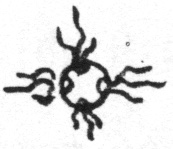
* Ivan the Gross. These are fireballs. Your device has something else. Find out and submit a correct blazon.
* John the Idiota (mentioned in the 22 October letter). Before submitting your device again please revise it: I neglected to mention that we don't use quarterly in equerre. (Sorry!) I doubt if it's English heraldry; it certainly isn't in Parker's Glossary.
* Kathryn of Iveragh. The design is pretty but complex. I think there may be a simpler way of blazoning it; what does it represent? If it's part of the cooling system of a philosopher's engine [that's nuclear reactor, not computer, which is "golem"], we might want to blazon it in terms of rings rather than roundels voided.
* Mandrax Boru. "Quaalude" (the name of a tranquilizer) is given as the meaning of "Mandrax." This looks like an attempt to create an "old" form of mandrake or mandragora, a plant used to make sleeping potions. The original form is classical Greek (transliterated) mandragoras. I doubt if the form Mandrax would "look Irish" to anyone acquainted with the language. The name Boru, here treated as a surname (the applicant is "brother to Matthias Boru") is actually an agnomen: Boru derives from boroma, "tribute." Brian Boru did not inherit the name, nor did it descend to his sons. A pity to hold up a good device for lack of acceptable name. [Indonesia? You mean the Javanese Empire?]
* Nytha d'Hui. Explain the name. If the Lord Aten is not being facetious when he tells me that it comes from an exchange, "My lord, we have no record of a name for your SCA branch" - - "Well, Nytha do we!" ... it is unacceptable. Find another.
* Odric the Mad. "Triskelion" can refer to curved lines, but the most familiar heraldic example is that of the Isle of Man with three armored human legs, bent at the knee. The only SCA example is that of Marya of Zagomar. with straight lines bent knee-fashion. But compare the pentaskelion of Douglas Longshanks, which consists of five armored human legs. The term triquetra is in use in the Society for three objects arranged radially; in my opinion, "three scythe-blades in triguetra" gives a clearer description of the charge in question.
*
Rahlina del Norte. Resubmit with corrected blazon or emblazon. A crescent is this, ![]() not this
not this ![]() in heraldry. "The aureole of the sun" is not heraldic terminology. Call it "a sun voided" if you must have it.
in heraldry. "The aureole of the sun" is not heraldic terminology. Call it "a sun voided" if you must have it.
* Rondelles dex Aureaux. You've got to be kidding! "In the sky above a green and yellow pavilion, an Oreo cookie with a bite out." No way.
* Saher Faux. Is this the French word faux, false, or what? [Too bad, because It's very pretty. A shame to have to reject it. You'd think they'd learn.]
* Tagan the Talesmythe, badge. The dragon is more conspicuous than the castle, so that the badge infringes Akataro Minimoto and Starkad Maledon (p. 163 in the May XI edition of the Ordinary).
* Tanasan Dimrithil. Conflicts with Roberta Lynn: Sable, within a Bowen knot in cross argent, a heart Or. Change a tincture or the position of the Bower knot--though not so blazoned, this one is in cross also.
* Tess of Ambergeen. In what language does this mean "Land of Amber"? The position of the bird is "displayed, ' not "rising." What is the Veiled Council of Valadin? Is it authorized by the Crown?
* Wolfangus of the Highlands. Conflicts with Surgon, Azure a wolf statant argent.
* One out-of-sequence note. Keith Robertson's R-rune badge, passed in the 22 October letter, was submitted by the West in 1972, and apparently lost in the transition of the Laurel's files to Atenveldt. One more loose end tied up.
I remain at your service,
/s Karina FarWest
Karina of the Far West
O.L., Pel., Baroness
Laurel Queen of Arms
KFW: dcm
cc: Clarion
Laurel Emeritus
Steward/Banner